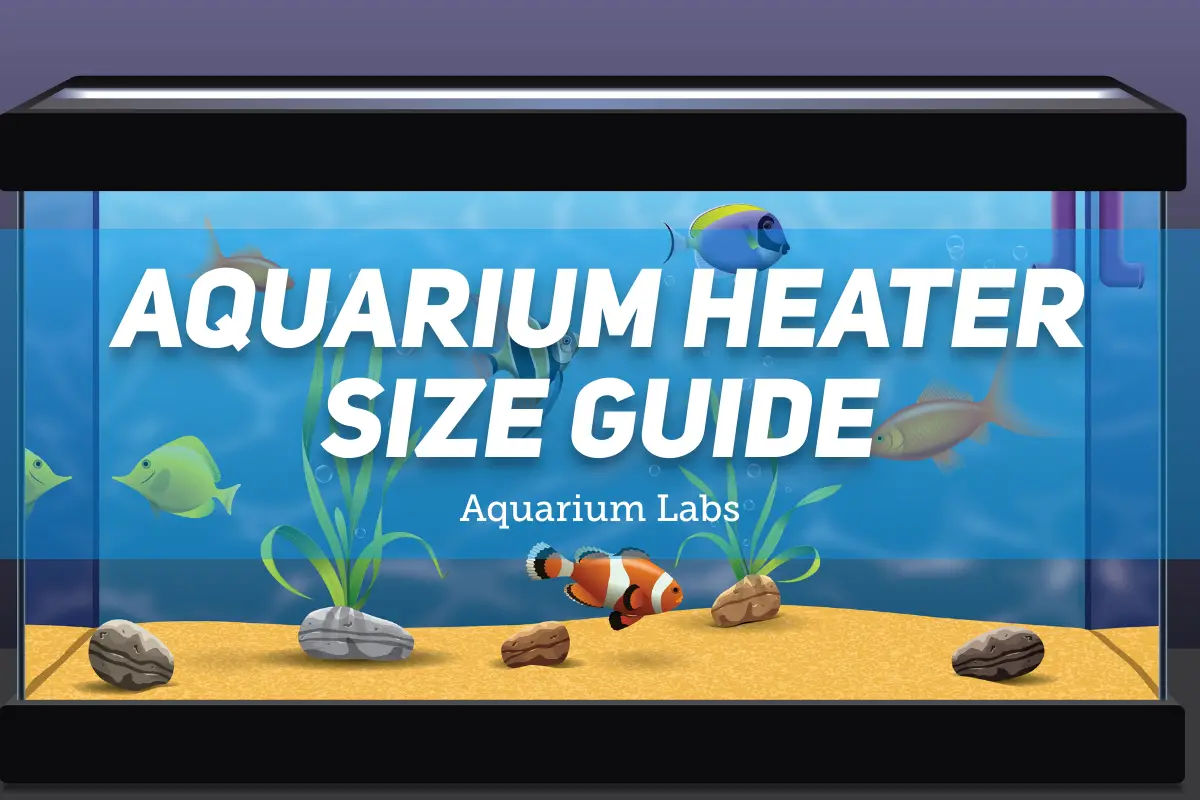When setting up an aquarium, your goal is to create a little bubble of the environment that your fish and other aquatic critters would live in if they were in the wild—that includes water temperature.
Aside from cold-water species, such as goldfish, that usually require an aquarium heater, and it’s essential to choose the right heater size for your fish tank to maintain the right temperature consistently.
There’s no one-size-fits-all solution when it comes to aquarium heaters. The heater you need depends on the size tank you have, the volume of water you keep in your fish tank, the temperature the tank needs to be at, the room temperature, and more.

There are a variety of ways to take these factors into account. While many people just use the ‘per gallon’ ratio, other elements are just as important if you want to maintain the right aquarium water temperature for your fish.
In our aquarium heater guide, we’ll take a closer look at heater types, sizes, tips, and more. Make sure to read all the information in this guide before you shop for your next aquarium heater.
Types of Aquarium Heaters
The first step to choosing the best aquarium heater size is deciding which design to buy. There are various types of heaters available on the market. Let’s take a look at three popular fish tank heater designs:
Submersible
Submersible water heaters are one of the most effective design options. As these units are completely submerged in your tank’s water, they can provide effective temperature control so long as the heater wattage is sufficient.
These aquarium heaters come in various shapes and sizes, as well as horizontal and vertical models. A submersible is the right aquarium heater to use if you want to provide even heating throughout a large fish tank.
Hang-On Tank
A hang-on tank heater is often considered the least efficient choice on the market. While designs can vary, this option typically uses suction cups to attach to the aquarium’s back or side and hangs just below the water level. The heater will not be fully submerged into the water, which means it might not have a drastic impact on the overall water temperature.
As a rule of thumb, this is not the right aquarium heater if you have an extremely large tank. Due to the design’s inefficient nature, this type of product is best suited to small aquariums, such as a betta fish habitat in a 5-gallon tank that don’t require the same level of temperature control.
If you choose to purchase a hang-on heater for a larger aquarium, it might be worth purchasing two or more. By using multiple hang-on heaters, you can ensure you’re not unevenly heating your tank.
Heating Cable
A heating cable, sometimes called a substrate heater, is a tank heater that runs along the bottom of your aquarium. It’s usually covered by gravel and includes an external control unit. As with submersible heaters, this is an excellent option for large tanks that require even temperature distribution.
However, a heating cable is not a good idea if you own a saltwater tank with corals or have a lot of plants. If the cable breaks, or you need to replace it, you’ll have to dig up the bottom of your tank to access the device. While this isn’t impossible with a reef tank, it’s much more difficult—there are easier ways to control the temperature in your tank.
Finding What Size Heater You Need for Your Aquarium

Once you decide on the heater design that’s right for your tank, it’s time to determine which size, or wattage, is suitable.
It’s critical to choose a device that can provide enough aquarium heat to maintain a healthy environment for your fish.
There are three elements to consider to determine the right heater for your aquarium size: room temperature, aquarium water volume, and desired temperature.
Most aquarium experts recommend that you determine your heater’s power in terms of watts per gallon (WPG). Typically, you will need around 2.5 to 5 watts per gallon in your tank.
So, for example, a 10-gallon aquarium would need a 25- to 50-watt heater.
Still, this is only a rough estimate—you will also need to consider the room temperature to make an accurate calculation.
If your room temperature is low, you will need a larger heater to raise the water temperature in your tank—a cold room may require more than 5 watts for each gallon of water.
You should subtract the average room temperature from your desired water temperature. The temp difference will allow you to determine the total heating power output required using this aquarium heater size guide. It displays fish tank volumes and temperature intervals for how much additional heat you need in your tank.
For example, let’s say you have the following situation:
- Target Temperature = 77 degrees F
- Average Room Temperature = 67 degrees F
- Required Heating = 77 F – 67 F = 10 F
- Tank Size = 40 gallons
To figure out the required heater size, use the table below:
| Tank Size | Heat (9°F/5°C) | Heat (18°F/10°C) | Heat (27°F/15°C) |
|---|---|---|---|
| 6 Gallon (20 Liter) | 25 Watt | 50 Watt | 75 Watt |
| 10 Gallon (40 Liter) | 50 Watt | 75 Watt | 75 Watt |
| 20 Gallon (75 Liter) | 50 Watt | 75 Watt | 150 Watt |
| 25 Gallon (100 Liter) | 75 Watt | 100 Watt | 200 Watt |
| 40 Gallon (150 Liter) | 100 Watt | 150 Watt | 300 Watt |
| 50 Gallon (200 Liter) | 150 Watt | 200 Watt | 200 Watt (x2) |
| 65 Gallon (250 Liter) | 200 Watt | 250 Watt | 250 Watt (x2) |
| 75 Gallon (300 Liter) | 250 Watt | 300 Watt | 300 Watt (x2) |
For the example above, we’d need approximately a 100 Watt heater!
If you’re planning on purchasing multiple heaters, add the number of watts together to determine if you have enough power. The cumulative number of watts will indicate if your heater is large enough.
Aquarium Heater Tips
Now that you have an idea of the heater type and size you need, we have a few more tips for you. Before you decide on a specific tank heater, it’s important to keep these points in mind.
In this section of our article, we’ll take a closer look at some tips and topics that can help you better understand aquarium heaters.
Heater for Aquarium: Saltwater or Freshwater?
The type of fish tank you own is critically important if you’re trying to choose a heater. While we already discussed the reasons a heating cable is not suitable for a saltwater or planted tank, it’s essential to understand the effect that temperature has on different fish.
For instance, saltwater fish that live in tropical environments are much more capable of withstanding warmer temperatures.
On the other hand, some freshwater fish and coldwater fish can handle much colder temperatures. Research your fish’s optimal environment before you purchase a heater—you shouldn’t mix fish that require different water conditions.
Use an Aquarium Thermometer
While some heaters come with temperature dials that act as a manual thermostat to set temperature levels, never rely on your heater to provide optimal performance.
Monitoring the internal climate in your tank is the best way to avoid dangerous temperature levels. Ensure the aquarium thermometer you choose has a clear temperature display so that you can easily gauge the temperature in your tank.
Consider Insulation
Temperatures can be impacted by the insulation properties of your fish tank. If your tank doesn’t have thick glass, heat may escape if the aquarium’s room temperature is too cold.
This is a much harder element to gauge, so it’s a good idea to speak to your aquarium manufacturer or provider about the level of insulation that you can expect from the tank’s materials.
In most cases, aquarium glass is quite thick and will provide reliable insulation if you have a quality heater.
Keep Tabs on Room Temperature
As mentioned, the room temperature surrounding your aquarium plays a huge role in your heater’s efficiency.
It’s always important to keep tabs on your room temperature after any significant external climate changes. If your room temperature suddenly drops, it’s essential to check that your heater keeps up with the extra demand.
Verify There’s Enough Space
While some fish tank heaters are designed to be compact, it’s still important to ensure you have enough space.
If you’re already using a canister filter on your home aquarium or other bulky equipment, you might find it difficult to place a large heater on the same tank.
For safety reasons, your heater also shouldn’t be placed near any decorations, plants, or your filter output or inlet. If you have long flowing plants, you may even consider a heater guard.
Heater Tube Length Matters
If you have a heater tube, you should always ensure that it will cover the length of your tank. Heat rises, which means that the warmer water will naturally flow to the top of your tank. It’s essential to find a tube built for your fish tank size to ensure that the lower areas of your aquarium are still receiving heat—short heater tubes will not distribute temperature evenly.
Water Flow Matters
If you’re trying to control the tank temperature, the water current can greatly impact your ability to heat your aquarium. Using an aquarium filter with enough power to produce proper water circulation can help you maintain healthy conditions. Otherwise, the heat distribution and temperature range may vary in different areas of your tank.
Check Your Energy Bills
One of the few cons of incorporating a heater into your aquarium set-up is the cost of powering it. While most water heaters won’t make a noticeable impact on your energy bills, it’s still important to choose an efficient product if you want to avoid downstream costs.
If you’ve never used a heater in the past, always assess your energy bills before and after you begin heating your water. Aquarium heating should not cause a large impact on the cost of your monthly energy. If it does, something is wrong.
Unplug Your Heater When You Clean Your Tank
If you empty water from your tank during maintenance, such as cleaning, it’s essential to unplug your water heater. If you don’t, the heating device may overheat. If there is no water to cool down the internal heating system, it can quickly reach temperature levels that can create dangerous damage to the heater.
It’s Time to Pick the Perfect Aquarium Heater Size
Now that you’ve explored our information on heater sizes and designs, it’s time to ensure that your aquarium fish benefit from one of the best products on the market.
With so many leading water heater brands, from Eheim to Aqueon, available to modern aquarium owners, there’s never been a better time to purchase a world-class product that can keep your water at an optimal temperature.
Use the information provided in our guide to find the right tank heater size, and always remember to monitor your tank temperature to make adjustments as necessary for the type of fish in your aquarium.
If you need additional information about any other aquarium topics, check out the other articles on our website. We aim to create quality content and answer all your aquarium questions!
Related: Where to Place Your Aquarium Heater(s)

